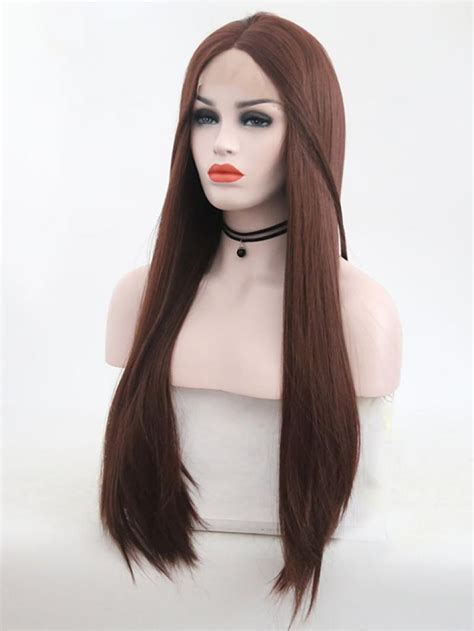Types of Wigs
There are numerous types of wigs available today, each offering unique benefits and uses:

1. Lace Front Wigs
– Features transparent lace that creates the illusion of a natural hairline.
– Provides a realistic and undetectable appearance.
– Requires professional installation and maintenance.
2. Full Lace Wigs
– Constructed with delicate lace that covers the entire head.
– Allows for ultimate versatility in styling and parting.
– More breathable than lace front wigs but requires expert installation.
3. Capless Wigs
– Relies on adjustable straps and combs for secure attachment.
– Provides excellent ventilation, making it comfortable to wear for long periods.
– Lacks the natural appearance of lace wigs.
4. Synthetic Wigs
– Made from artificial fibers, offering a range of styles and colors.
– Affordable and easy to maintain.
– Can be prone to tangling and matting.
5. Human Hair Wigs
– Crafted from human hair, providing a soft and natural feel.
– Customizable and can be styled using heat tools.
– Requires more maintenance and is more expensive than synthetic wigs.
Choosing the Right Wig
The key to choosing the right wig is to consider your personal style, preferences, and lifestyle:
1. Face Shape
– Round faces: Opt for wigs with volume on top and layers around the face.
– Oval faces: Any wig style is flattering.
– Square faces: Choose wigs with soft, rounded edges to balance angles.
– Heart-shaped faces: Select wigs with wider foreheads and narrower chins.
2. Hair Type and Texture
– Straight hair: Go for wigs that mimic your natural texture or explore styles with curls or waves.
– Curly hair: Choose wigs with defined curls or opt for straight styles for a contrasting look.
– Fine hair: Select wigs with extra volume to create the illusion of thicker hair.
3. Lifestyle
– Active lifestyle: Consider wigs that are easy to maintain and secure.
– Social events: Opt for wigs with a natural hairline or full lace construction for a sophisticated look.
– Work environment: Choose wigs that are professional and modest in style.
Benefits of Wearing Wigs
The benefits of wearing wigs extend beyond aesthetic appeal:
- Hair Transformation: Instantly change your hairstyle, color, and texture without damaging your natural hair.
- Confidence Boost: Wigs can help enhance self-esteem and make you feel more attractive.
- Hair Loss Solutions: Wigs can provide discreet coverage for those experiencing hair loss due to medical conditions or treatments.
- Protective Styling: Wigs allow you to protect your natural hair from styling tools, chemicals, and environmental factors.
- Versatile Fashion: Wigs complement any outfit, adding instant glamour or versatility to your wardrobe.
Common Mistakes to Avoid
To maximize your wig-wearing experience, avoid common pitfalls:
- Choosing the Wrong Style: Carefully consider your face shape and lifestyle when selecting a wig to ensure a flattering fit.
- Over-Styling: Avoid excessive heat styling and product buildup, which can damage the wig or make it appear unnatural.
- Ignoring Maintenance: Regular cleaning and conditioning are essential to maintain the quality and longevity of your wig.
- Purchasing Cheap Wigs: Low-quality wigs are often made with inferior materials that can be uncomfortable and look artificial.
- Improper Application: Ensure you secure your wig correctly and adjust the straps for a snug and natural fit.
Why Wigs Matter
Wigs have evolved into a symbol of empowerment, self-expression, and hair artistry:
1. Personal Style: Wigs allow individuals to experiment with different styles and explore their creativity.
2. Confidence and Self-Esteem: Wigs can boost self-confidence and help individuals feel comfortable in their own skin.
3. Hair Loss Support: For those experiencing hair loss, wigs provide a comforting and practical solution.
4. Trendsetting: Wigs are often used by celebrities, fashion icons, and hair stylists to create statement-making looks.
5. Historical Significance: Wigs have been an integral part of fashion, theater, and cultural traditions throughout history.
Creative Applications of Wigs
Beyond traditional uses, wigs inspire innovative applications in various industries:
- Cosplay and Performing Arts: Wigs transform performers into characters, enabling them to fully embody different roles.
- Special Effects and Movie Making: Wigs create realistic costumes and enhance character development in film and television productions.
- Cosmetology Education: Wigs provide students with hands-on training for cutting, styling, and coloring hair.
- Fashion Experimentation: Wigs allow designers and stylists to experiment with new looks and trends without committing to permanent hair changes.
- Wig-making as Art: Wigs have become canvases for artisans who create elaborate and breathtaking wearable sculptures.
Additional Information
- According to a study by the American Hair Loss Association, over 50 million Americans experience hair loss.
- The global wig market is projected to reach $14.6 billion by 2027, driven by increasing demand for hair loss solutions and fashion accessories.
- The term “wiglet” refers to a partial wig or hairpiece used to add volume or cover specific areas of the scalp.
- Human hair wigs can range in price from $500 to $5,000, while synthetic wigs typically cost between $25 and $200.
- Wigs require regular cleaning and maintenance, with synthetic wigs being easier to care for than human hair wigs.
Useful Tables
Table 1: Types of Wigs and Their Features
| Type | Description | Pros | Cons |
|---|---|---|---|
| Lace Front | Transparent lace for natural hairline | Realistic | Professional installation required |
| Full Lace | Lace covers entire head | Versatile | Expert installation needed |
| Capless | Adjustable straps | Comfortable | Less natural appearance |
| Synthetic | Artificial fibers | Affordable | Can tang |
